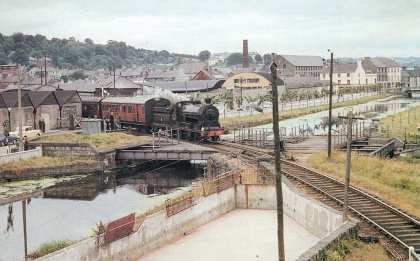It was sixty feet wide, twelve feet deep and capable of handling vessels of up to one hundred and fifty tons. This was well in excess of the average tonnage of ocean-going vessels of the time, but unfortunately developments in ship-building soon led to much larger ships quite incapable of navigating this narrow and shallow waterway. Newry Ship Canal was unfit for purpose (much like the inland canal that preceded it) within decades of its construction.
It did however serve a very useful purpose for more than a century, especially in the importation of such primary materials as timber and coals, and for the export of agricultural produce.
Other cargoes were of course carried in abundance over that century. Sugar Island was the final destination of much imported sugar from the Caribbean. Perhaps we should walk in the mind’s eye along the route of that waterway from the perspective of people of that time.
‘The Salt Works was the warehouse furthest north of the mouth of the tidal river.
Then we had the docks adjacent to Beatty’s Mill.
Close by too vessels unloaded materials for Felix O’Hagan’s Mill, although his premises were located at the junction of Edward and Catherine Streets.
The coal yards of Mr Greer, usually a very busy place, were sited next to the yards of Carville & Company. It was not just coal that was unloaded here but lumber from the New World, to be further carried all over the North of Ireland.
Further down the Quay were the premises of Redmond and Company. Redmond was a merchant of slate, sand, cement and steel for the manufacture of spades and shovels. There were a number of the latter in the vicinity, notably one adjoining the railway line at Monaghan Street beside Haldane’s, Builders’ Suppliers.
Close to Ballybot Bridge was the site of a weaving factory as well as Fennell’s Mill. Ships would dock beside a large crane there, with a huge bucked attached. The bucket was lowered into the ship’s cargo hold where it would scoop up the corn and swing it across the road to be deposited in the maw of Fennell’s Mill. In Mill Street was Walker‘s Mill said to be one of the first establishments in Europe to have electrical light of its own generating.
The largest, busiest and most enduring establishment at the south end was the warehouse of the ‘Dundalk and Newry Steampacket Company’. Quay porters loaded steam ships by hand here across wooden planks. There were other cargos at different times. For many decades the local granite was in great building demand ‘across the water’. There were hides, and finished leather from many Newry tanneries, distilled spirits in casks and kegs from the warehouses of Matt D’Arcy and Company and from Henry Thompsons; there were crated fowl and livestock for the Liverpool market; bales of linen yarn and many other commodities manufactured in or near the town.’
The Ship Canal continued its thriving business up until Tuesday 26th March 1974. On that date the ‘Anna Broere’ sailed as far as the Burma Oil Depot on the Fathom Line to discharge a cargo of 650 tons of acetone. On the following day it exited the Newry Ship Canal to bring an illustrious era to a close.
Soon after the swing bridges at Dublin Bridge, Ballybot, Monaghan Street and Sugar Island were turned into fixed bridges and another era was ended.
